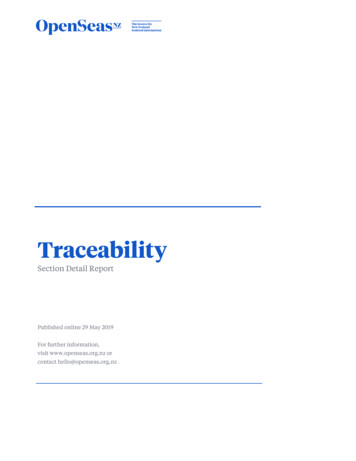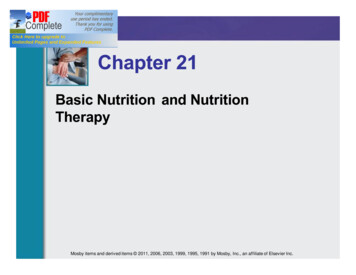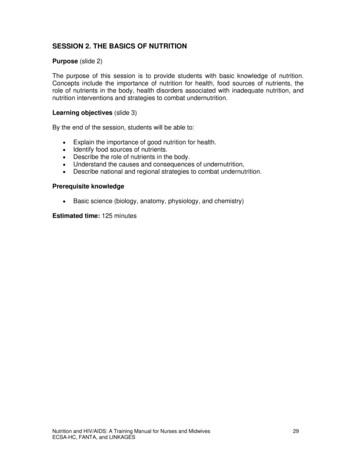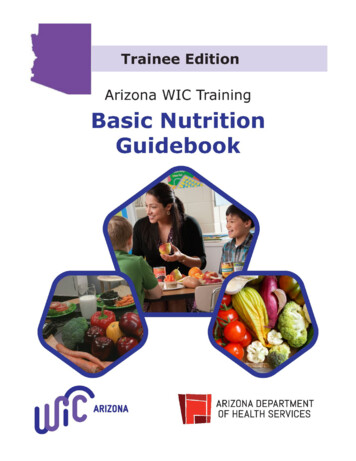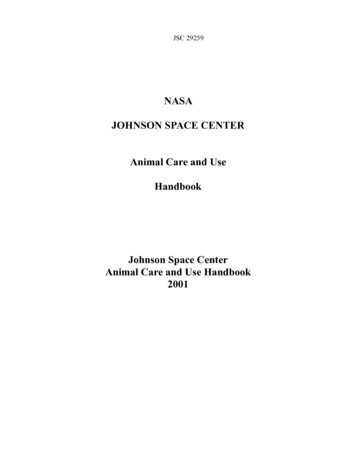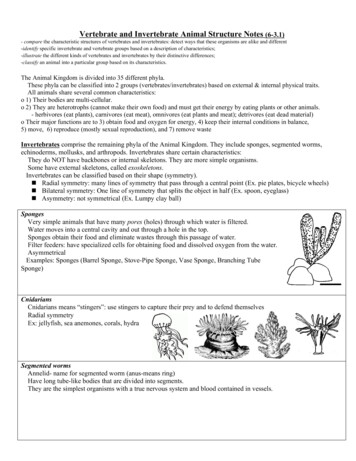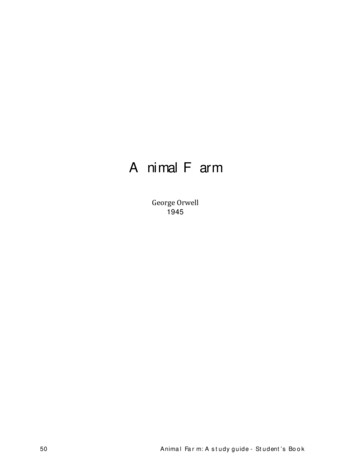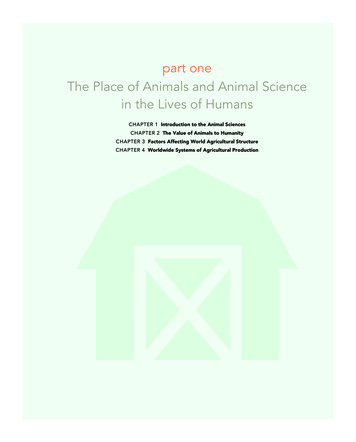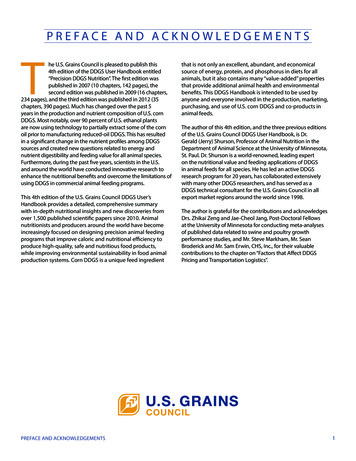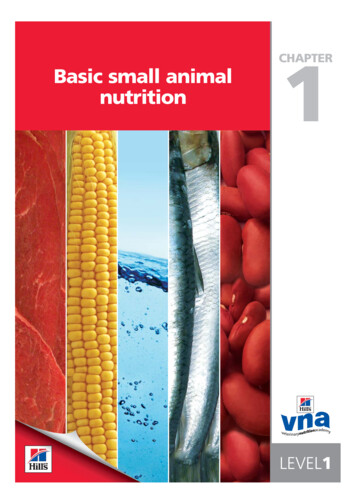
Transcription
p22623 gg hill's 2011 vna mas chapter 1 VNA 2005 Master 05/12/2011 08:55 Page 1CHAPTERBasic small animalnutrition1LEVEL1
VNA 1 CHAPTER 1p22623 gg hill's 2011 vna mas chapter 1 VNA 2005 Master 05/12/2011 08:55 Page 2CContents1Nutrients1.1 Water . . . . . . . . . . . . . . . . . . . . . . . . . . . . . . . . . . . . . . . . . . . 71.2 Carbohydrates . . . . . . . . . . . . . . . . . . . . . . . . . . . . . . . . . . . . 81.2.1 Function . . . . . . . . . . . . . . . . . . . . . . . . . . . . . . . . . . . . . 9Simple carbohydrates and starches . . . . . . . . . . . . . . . 9Fibre . . . . . . . . . . . . . . . . . . . . . . . . . . . . . . . . . . . . . . . 91.2.2 Digestion . . . . . . . . . . . . . . . . . . . . . . . . . . . . . . . . . . . . 10Simple carbohydrates and starches . . . . . . . . . . . . . . 10Fibre . . . . . . . . . . . . . . . . . . . . . . . . . . . . . . . . . . . . . . 101.2.3 Recommended levels . . . . . . . . . . . . . . . . . . . . . . . . . . 111.3 Proteins . . . . . . . . . . . . . . . . . . . . . . . . . . . . . . . . . . . . . . . . . 121.3.1 Function . . . . . . . . . . . . . . . . . . . . . . . . . . . . . . . . . . . . 141.3.2 Digestion . . . . . . . . . . . . . . . . . . . . . . . . . . . . . . . . . . . . 151.3.3 Recommended levels . . . . . . . . . . . . . . . . . . . . . . . . . . 171.3.4 Excess or deficiencies . . . . . . . . . . . . . . . . . . . . . . . . . . 191.4 Fat . . . . . . . . . . . . . . . . . . . . . . . . . . . . . . . . . . . . . . . . . . . . 191.4.1 Function . . . . . . . . . . . . . . . . . . . . . . . . . . . . . . . . . . . . 211.4.2 Digestion . . . . . . . . . . . . . . . . . . . . . . . . . . . . . . . . . . . . 221.4.3 Recommended levels . . . . . . . . . . . . . . . . . . . . . . . . . . 221.4.4 Excess or deficiencies . . . . . . . . . . . . . . . . . . . . . . . . . . 23 Summary of key points Self-assessment questions Building your portfolio1.5 Minerals . . . . . . . . . . . . . . . . . . . . . . . . . . . . . . . . . . . . . . . . 271.5.1 Function . . . . . . . . . . . . . . . . . . . . . . . . . . . . . . . . . . . . 281.5.2 Absorption . . . . . . . . . . . . . . . . . . . . . . . . . . . . . . . . . . 291.5.3 Recommended levels . . . . . . . . . . . . . . . . . . . . . . . . . . 301.5.4 Individual minerals . . . . . . . . . . . . . . . . . . . . . . . . . . . . 31Calcium and phosphorus . . . . . . . . . . . . . . . . . . . . . . 31Sodium, potassium and chloride . . . . . . . . . . . . . . . . 32Magnesium . . . . . . . . . . . . . . . . . . . . . . . . . . . . . . . . 33Iron . . . . . . . . . . . . . . . . . . . . . . . . . . . . . . . . . . . . . . 33Zinc . . . . . . . . . . . . . . . . . . . . . . . . . . . . . . . . . . . . . . 33Copper . . . . . . . . . . . . . . . . . . . . . . . . . . . . . . . . . . . 34Selenium . . . . . . . . . . . . . . . . . . . . . . . . . . . . . . . . . . 341.6 Antioxidants . . . . . . . . . . . . . . . . . . . . . . . . . . . . . . . . . . . . . 352
1.7 Vitamins . . . . . . . . . . . . . . . . . . . . . . . . . . . . . . . . . . . . . . . . 371.7.1 Function . . . . . . . . . . . . . . . . . . . . . . . . . . . . . . . . . . . . 371.7.2 Absorption . . . . . . . . . . . . . . . . . . . . . . . . . . . . . . . . . . 381.7.3 Recommended levels . . . . . . . . . . . . . . . . . . . . . . . . . . 391.7.4 Individual vitamins . . . . . . . . . . . . . . . . . . . . . . . . . . . . . 40Vitamin A . . . . . . . . . . . . . . . . . . . . . . . . . . . . . . . . . . 40Vitamin D . . . . . . . . . . . . . . . . . . . . . . . . . . . . . . . . . . 40Vitamin E . . . . . . . . . . . . . . . . . . . . . . . . . . . . . . . . . . 41Vitamin K . . . . . . . . . . . . . . . . . . . . . . . . . . . . . . . . . . 41Vitamin B-complex . . . . . . . . . . . . . . . . . . . . . . . . . . . 42Vitamin C . . . . . . . . . . . . . . . . . . . . . . . . . . . . . . . . . . 42L-Carnitine . . . . . . . . . . . . . . . . . . . . . . . . . . . . . . . . . 42Carotenoids . . . . . . . . . . . . . . . . . . . . . . . . . . . . . . . . 43Flavonoids . . . . . . . . . . . . . . . . . . . . . . . . . . . . . . . . . 43 Summary of key points Self-assessment questions Building your portfolio2Energy2.1 Energy content of food . . . . . . . . . . . . . . . . . . . . . . . . . . . . 472.2 Calculation of energy requirements . . . . . . . . . . . . . . . . . . . 482.3 Energy requirements . . . . . . . . . . . . . . . . . . . . . . . . . . . . . . . 49 Summary of key points Self-assessment questions Building your portfolio3Nutrient content of food3.1 As fed comparison . . . . . . . . . . . . . . . . . . . . . . . . . . . . . . . . 543.2 Dry matter comparison . . . . . . . . . . . . . . . . . . . . . . . . . . . . . 553.3 Energy basis comparison . . . . . . . . . . . . . . . . . . . . . . . . . . . 56 Summary of key points Self-assessment questions Building your portfolio4Differences between dogs and cats Summary of key points Self-assessment questions Building your portfolio3VNA 1 CHAPTER 1p22623 gg hill's 2011 vna mas chapter 1 VNA 2005 Master 05/12/2011 08:55 Page 3
VNA 1 CHAPTER 1p22623 gg hill's 2011 vna mas chapter 1 VNA 2005 Master 05/12/2011 08:55 Page 44
LLearning outcomesThis chapter covers the basic terminology and concepts of nutrition and howthese can be applied. By the end of this chapter, you will have gained a set ofskills that will enable you to: define and explain basic terminology like proteins, amino acids, energy etc. advise clients with the best possible recommendations based on yourunderstanding of the importance of the different nutrients compare two different pet foods based on calculations on dry matter basisand energy basis provide correct recommendations for how much food to feed per day bycalculating the Daily Energy Requirement (DER) explain the reason why cats and dogs need different types of food.To help you see how you are doing, self-evaluation questions are giventhroughout the text. Answering these questions will also be good practice forthe final exam.If you are doing well with these questions, the final exam may prove a pieceof cake. Remember, VNA is supposed to be a lot of fun on which you canbuild your daily work and maybe future career.5VNA 1 CHAPTER 1p22623 gg hill's 2011 vna mas chapter 1 VNA 2005 Master 05/12/2011 08:55 Page 5
VNA 1 CHAPTER 1p22623 gg hill's 2011 vna mas chapter 1 VNA 2005 Master 05/12/2011 08:55 Page 61Nutrients“Nutriment is both food andpoison. The dosage makes iteither poison or remedy.T. B. von Hohenheim”Nutrients are divided into six basic categoriesCARBOHYDRATESPROTEINSFATLet your client knowDefinitionSome nutrients provide energy.Protein, fats and carbohydratesprovide the body with fuel, justlike petrol in a car.Nutrient: A metabolically usefulcomponent of food, which may beessential or non-essential.MINERALSVitaminsMicrograms to milligrams per dayFatEssential fatty acids: grams per dayProteinEssential amino acids: grams per dayNERGYMineralsMicrominerals: milligrams per dayMacrominerals: grams per dayCarbohydratesGlucose: grams per dayWaterkilograms per dayThe six basic nutrients. Carbohydrates, fats and proteins may be used for energy but also serve as structural components.6VITAMINSEssential nutrient: Any requirednutrient that cannot be synthesisedin the body and must be obtainedfrom the food.Different nutrients are needed invarying amounts per day. Forexample, both humans andanimals require kilograms of waterbut only micrograms of certainvitamins.ENUTRIENTSWATER
1.1 WaterWater is the most important nutrient of all and essential for life. Animals canlose almost all their fat and half their protein and still survive, but if they lose15% of their water, it will mean death.The amount of water an animal should consume per day is roughly equivalentto its daily energy intake in kilocalories. This means that a healthy dog or catwould normally need around 50 ml perkg bodyweight per day; e.g., 200 mlfor a 4kg cat.DefinitionThe proportion of energyproducing nutrients in fooddetermines its energy contentor energy density.Water has no energy value,so a food with a high moisturecontent will usually have a lowenergy density.VNA 1 CHAPTER 1p22623 gg hill's 2011 vna mas chapter 1 VNA 2005 Master 05/12/2011 08:55 Page 7Let your client know2. The amount of water a cator a dog drinks will varydepending on what food iteats. For example, cannedfood has a higher watercontent than dry food, soit provides part of the dailywater requirement.Clinical noteA pet needs extra water whenwater losses increase. This could bedue to: increased temperature of thesurroundings (causes pantingand loss of moisture) lactation increased body temperature polyuria (increased urineproduction) diarrhoea vomiting severe bleeding.7NUTRIENTS – Water1. Clean, fresh water shouldalways be freely availableexcept if the pet is persistentlyand excessively vomiting.
VNA 1 CHAPTER 1p22623 gg hill's 2011 vna mas chapter 1 VNA 2005 Master 05/12/2011 08:55 Page 8Energy-producing nutrientsThe nutrients that supply us with energy are carbohydrates, proteins and fat.1.2 CarbohydratesHOCH2 OHO OHOHNUTRIENTS – es are:3. Polysaccharides (poly: many)1. Simple sugars Starches (e.g., amylose,glycogen) Monosaccharides (e.g., glucose)(Mono: one; saccharide: sugar) Disaccharides (e.g., lactose)which consist of two sugar units(di: two) Fibres (e.g., cellulose, pectins)Polysaccharides are also calledcomplex carbohydrates and canbe defined based on digestibility.2. Oligosaccharides (oligo: few) 3–9 sugar units (e.g., raffinose) If they contain fructose, they arecalled fructooligosaccharides(FOS)Composition of the dietary carbohydrate,glucose. Glucose is classified as yLactoseMilkDairy products (milk esting factWhen glucose is metabolised asenergy, ATP (the ‘gasoline of thecell’), carbon dioxide and waterare the end products.Slowly fermentable fibre like celluloseWheat branModerately fermentable fibreRice branPea fibreWheat branRapidly fermentable fibreApplesCitrus pulpGuar gum8
Clinical noteExcess carbohydrates will beconverted into body fat.Simple carbohydrates and starches in foods are used by the body as a sourceof glucose. As such, they have several major functions, they:1. provide energyInteresting fact2. produce heat when they are metabolised for energySugars in starches are linked insuch a way that the enzymes inmammals’ digestive systems canbreak them down. Sugars in fibreare linked so that only enzymesfrom bacteria can break themdown.3. can be used as building blocks for other nutrients (e.g., certain aminoacids, lactose (the sugar in milk) and vitamin C)4. provide storage of energy in the form of glycogen or fat.Function of fibreLet your client knowFibre has two major functions:1. to promote and regulate normal bowel function: in dogs with slow transit time, fibre shortens it in dogs with rapid transit time, fibre increases it2. to help maintain the health of the colon, e.g., by providing fuel for cells.9Fibre increases bulk and waterin the intestinal content, whichmeans that fibre helps preventboth constipation and diarrhoea.Remember that a pet withconstipation needs to drink lotsof water for the fibre to havean effect.NUTRIENTS – Carbohydrates1.2.1 Function of simple carbohydratesand starchesVNA 1 CHAPTER 1p22623 gg hill's 2011 vna mas chapter 1 VNA 2005 Master 05/12/2011 08:55 Page 9
VNA 1 CHAPTER 1p22623 gg hill's 2011 vna mas chapter 1 VNA 2005 Master 05/12/2011 08:56 Page 10Clinical noteDogs and cats lack the enzymeamylase in their saliva. Therefore,starch does not break down in themouth. This is one of the reasonsthat cats and dogs do not developcaries as much as humans.1.2.2 Digestion of simple carbohydratesand starchesDigestion of simple carbohydrates and starches occurs throughout thedigestive tract and involves:a. mechanical processes: break down in the mouthb. enzymatic processes: the stomach – gastric juices (e.g., hydrochloric acid and peptic acid)– only a little carbohydrate digestion occurs hereInteresting factEnzymes secreted by the pancreasdigest the majority of starches andsugars in the lumen of the smallintestine. Enzymes at the smallintestinal mucosal brush borderare important in the final stages ofcarbohydrate digestion andabsorption. small intestine – enzymes – most of the carbohydrate digestiontakes place herec. microbial processes: large intestine – intestinal microbes (bacteria) produce enzymes additional energy is produced here by fermentation of fibres.NUTRIENTS – CarbohydratesLine of dissectionEsophagusKidneyFundusPortion ofthe stomachCardiac portionof the stomachDescending colonUreterGastricfoldsLiverUrinary bladderPyloricantrumStomachSpleenSmall intestineBody portion ofthe stomachDigestion of fibreClinical noteThe very edge, towards thelumen of the lining of the gutis called the ‘brush border’. Thisarea produces enzymes used indigestion. One of the brush borderenzymes is lactase – the enzymethat breaks down lactose. Adultdogs and cats produce very littlelactase and therefore haveproblems with digesting milk.Fermentation is the process where carbohydrates are broken down in anenvironment with little or no oxygen in such a way that they yield energy.The bacteria (microbes) in the large intestine are called anaerobes (an:without) because they can live without oxygen. To produce energy for survival,they have to use fermentation. The microbes only use part of the energy thatbecomes available through fermentation and the rest can benefit the mucosalcells of the intestine.Interesting factThe energy that microbes produceis in the form of smaller, energycontaining compounds called shortchain fatty acids, and in the formof gases.10Short-chain fatty acids are valuablesubstrates for the host animal asthey can be used for energy by themucosal cells.
Clinical noteModerately and slowlyfermentable fibres bulk up thefaeces by holding water. Slowlyfermentable fibre has severaladvantages:Helps to manage obesity: by reducing interactions offood particles with digestiveenzymes and epithelialsurfaces, so the nutrients aredigested less and thereforeprovide fewer caloriesVNA 1 CHAPTER 1p22623 gg hill's 2011 vna mas chapter 1 VNA 2005 Master 05/12/2011 08:56 Page 11 by slowing down theabsorption of nutrientsSome fibres are more rapidly fermented than others (see figure below). Themore rapidly a fibre is fermented, the more gases and short-chain fatty acidsare produced in a short period of time. The rate and extent of fibrefermentation are important characteristics when discussing physiologicfunctions of fibre.Soy fibre by reducing the surge in bloodsugar that happens after meals(beneficial in diabetes mellitus)Increases faecal bulk whichhelps alleviate the symptoms of: inflammatory bowel diseaseand other GI disordersPectinGuar gumHelps to control diabetesmellitus:Rapidlyfermentable constipation.BranBeet pulpSoybean hullsLet your client knowPeanut hullsCelluloseSlowly fermentableRelative degree of fermentation of various dietary fibre sources in the gastrointestinaltract of dogs and cats.The more rapidly a fibre isfermented, the more intestinal gasis produced – in short, the pet willtend to fart more.1.2.3 Recommended levelsDogs and cats do not have an absolute requirement for carbohydrates intheir diet in the way that essential amino acids or fatty acids must beprovided. They do, however, have a requirement for adequate glucose orglucose precursors to provide essential fuel for the central nervous system.Without dietary carbohydrates, there is added strain on lipid and proteinmetabolism to supply the glucose precursors. Sugars and starches are aneconomical and easily digested energy source.11Clinical noteA high level of fermentable fibrein the diet may have a laxativeeffect. This can cause unpleasantflatulence and even diarrhoea ifthe pet is fed indiscriminately.NUTRIENTS – CarbohydratesBacteria: colour enhanced scanning electron micrograph (SEM) of Listeriamonocytogenes bacteria. by delaying gastric emptying,thus providing a sensation offullness for longer
VNA 1 CHAPTER 1p22623 gg hill's 2011 vna mas chapter 1 VNA 2005 Master 05/12/2011 08:56 Page 12CANINE CARBOHYDRATE REQUIREMENTSDry dog foods typically contain 30–60%carbohydrate, mostly starch and thiscauses no adverse affect. Research in dogshas shown that gestation and lactation increase theneed for glucose to support foetal growth and lactosesynthesis in milk. Diets with no or low content ofcarbohydrates cause a variety of problems: reduced number of live births lethargy reduced mothering abilities of the bitch foetal abnormalities embryo resorption reduced milk productionFELINE CARBOHYDRATE REQUIREMENTSNormally, cats can maintain adequateblood glucose levels when fed a diet witha low carbohydrate content and a highprotein content. Cats also have some unique metabolicdifferences that limit their ability to efficiently use largeNUTRIENTS – ProteinsClinical noteMore than 40% carbohydrate ondry matter basis causes problemsin cats, such as:a. maldigestion: diarrhoeaamounts of absorbed dietary carbohydrates. Levels ofcarbohydrate up to 35% of the food on a dry matterbasis (see p.55 for explanation of dry matter basis) aretolerated well by cats but if levels of carbohydrates aremore than 40% dry matter basis, problems can occur.1.3 ProteinsTo make a protein, amino acids are linked together in a long chain. The chainis then bundled into to a three-dimensional structure, like a tangled ball ofyarn. Although there are hundreds of different amino acids, only 21 are usedin animal proteins. bloating gas.b. adverse metabolic effects: hyperglycaemia excretion of significantamounts of glucose inthe urine.DefinitionProteins: large, complexmolecules composed of hundredsto thousands of amino acids.These 21 amino acids can be arranged in any combination giving an almostinfinite variety of naturally occurring proteins, each with its own characteristicproperties, e.g., the proteins of hair, skin, muscle, hormones or antibodies.12
Many amino acids can be synthesised from others within the body but thereare some that cannot be synthesised in sufficient quantities and thereforemust be supplied by food. These are called essential amino acids.Clinical noteTaurine, which is an essentialamino acid for cats but not fordogs, is only found in animaltissue.ESSENTIAL AMINO VNA 1 CHAPTER 1p22623 gg hill's 2011 vna mas chapter 1 VNA 2005 Master 05/12/2011 08:56 Page 13Interesting factAmino acids always contain fourgroups:1. A hydrogen (H) atom3. An amino group (NH2 – onenitrogen (N) and two hydrogen(H) atoms)2. A carboxyl group (COOH – onecarbon (C), two oxygen (O) anda hydrogen (H) atom)4. A chemical group that is specificfor each individual amino acid,e.g., Sulphur or alamino acidPeptide bondMany aminoacidsAll tissue is made up of protein,but some contains it in higherquantities than others. Muscletissue, for example, is very rich inprotein whereas fat tissue has arelatively low protein content.This is why the ingredient meatmeal is such an important sourceof protein.NH–CH–COOHnRcPeptide bondCarboxylamino acidR different chemical groups and thus amino acidsProtein structure.13NUTRIENTS – ProteinsClinical note
p22623 gg hill's 2011 vna mas chapter 1 VNA 2005 Master 05/12/2011 08:56 Page 14VNA 1 CHAPTER 11.3.1 FunctionProteins are the essential building blocks of all tissues and organs of the bodyincluding:1. cartilage, tendons and ligaments (collagen and elastin)2. the element of muscles that contract (actin and myosin)3. skin, hair and nails (keratin)4. blood proteins (haemoglobin, transferrin, albumin and globulins)5. enzymes6. hormones7. antibodies.BLOODPROTEINSHaemoglobin,transferrin, albuminand globulinsKERATINANTIBODIESSkin, hair and nailsproduced bylymphocytes in theimmune systemNUTRIENTS – ProteinsHORMONESInsulin, oestrogen,etc.COLLAGENAND ELASTINACTIN ANDMYOSINCartilage, tendonsand ligamentsare the filaments ofthe musclesENZYMESClinical noteCats have a higher total proteinrequirement than dogs. This isbecause, even if there is notenough protein available in thediet for replenishing ‘buildingblocks’, protein will still be usedto produce energy.This can cause health problemsif a cat starves or doesn’t getenough to eat, especially if it is ill,because protein will be used forenergy instead of repair.PRODUCT s are often described as the ‘backbone’ of cells because they have astructural role in all cell walls. Proteins are required for all tissue growth,replenishment and repair.If there is more protein available than necessary for building blocks, proteinsmay also be used as a source of dietary energy.14
DefinitionsEAA: Essential Amino AcidBV:a. closely match an animal’s requirements for themBiological Value.b. and when most are absorbed and retained (has a high digestibility).When a food protein has a high biological value, it is usually more expensive.However, the pet needs less of it compared to a protein with a low biologicalvalue because the necessary amino acids will be supplied more easilyand efficiently.1.3.2 DigestionInteresting factBiological value depends on: amino acid profile protein digestibility.Clinical noteDietary protein must be digested to be absorbed from the gut (see figure onthe next page).Digestion has several steps: Proteins are broken down in the stomach forming smaller fragmentsconsisting of many amino acids (polypeptides). This stage is performed bythe action of the enzyme pepsin in the presence of hydrochloric acid. Littleor no absorption occurs here. In the small intestine, the polypeptides are broken down into amino acidsthat can be absorbed through the intestinal wall. This takes place throughthe action of enzymes produced by the pancreas and by the cells lining thesmall intestine.15The profile of EAAs in eggmatches the requirements of mostanimals. Egg is very easily digestedin the intestines and has thereforebeen assigned a biological value of100. All other protein percentagesare relative to that of egg.DefinitionGelatine: a protein source derivedfrom animal collagen. Gelatine hasvery high digestibility but thebiological value is low because it isdeficient in the essential aminoacid tryptophan.NUTRIENTS – ProteinsThe quality of a protein is indicated by its Biological Value (BV). A protein issaid to have a high biological value if it supplies the essential amino acids(EAAs) in amounts which:VNA 1 CHAPTER 1p22623 gg hill's 2011 vna mas chapter 1 VNA 2005 Master 05/12/2011 08:56 Page 15
The absorbed amino acids are reassembled into ‘new’ proteins by the liver andother tissues of the body. The fate of amino acids after absorption falls intothree general categories:1. tissue protein synthesis2. synthesis of enzymes, albumin, hormones and other compounds3. surplus used for energy.NUTRIENTS – ProteinsVNA 1 CHAPTER 1p22623 gg hill's 2011 vna mas chapter 1 VNA 2005 Master 05/12/2011 08:56 Page 161. DIGESTIONHydrochloric acid produced inthe stomachProtein Polypeptides2. DIGESTIONEnzymes from pancreas andlining of small intestinePolypeptides Amino acids3. ABSORPTIONInto the bloodBlood flow from smallintestine to liver viaportal veinAmino acids passthrough blood4. ACTIVITY IN THE LIVER Synthesis of tissue proteins Synthesis of: enzymes albumin hormones etc. Surplus used as energy16
Even if you feed a diet with a high protein content, theexcess protein cannot be stored in the body. If the bodyhas a need for more amino acids than it gets from food,it will break down muscle tissue first and then bodyorgan tissues.VNA 1 CHAPTER 1p22623 gg hill's 2011 vna mas chapter 1 VNA 2005 Master 05/12/2011 08:56 Page 17PROTEIN CATABOLISMLIVERProtein breakdown leads to the production of ammonia,which is toxic to body cells. Ammonia is then convertedto the less toxic urea in the liver and excreted in the urine.AmmoniaAmino AcidsDefinitionUreaProteinThe build-up of new protein iscalled protein anabolism andthe breakdown is calledprotein catabolism.UrineKIDNEY1.3.3 Recommended levelsAdult animals need dietary protein to replace the amino acids that are used inthe body for tissue repair and new cells, to replenish old blood proteins and toreplace the loss of nitrogen via faeces, urine, sweat, hair etc.The amount of dietary protein that must be consumed each day is termed ‘themaintenance protein requirement’.The pathophysiological state of the pet can also mean that there is anincreased need of protein, e.g., patients with cancer, burns and trauma mayneed extra daily protein, because they are in a hypermetabolic state. (For moreinformation, read VNA 3). In simple terms, in these conditions you need a lotof extra protein as building blocks for tissue repair.Not only the amounts of protein but also the proportion of amino acids needto be correct. When amino acids are used for protein synthesis, all the aminoacids that are necessary to synthesise a specific protein must be present in therequired proportions. In other words, the closer the biological value is to 100,the better it is.DefinitionPathophysiology: the physiologyof disordered function, i.e., thephysiology of disease.Let your client knowYoung animals and pregnantand lactating animals needhigher amounts of proteinto promote growth.DefinitionAAFCO: the agency that developsofficial pet food regulations in theUnited States.CANINE PROTEIN REQUIREMENTSThe absolute minimum dietary proteinrequirement for dogs that are fed anextremely high-quality protein is 6.0%on a dry matter basis for adult dogs and 9.5% ona dry matter basis for growing dogs. However, this isextremely low. The American Association of FeedControl Officials (AAFCO) has established that arecommended daily allowance of protein with an averagebiological value for growing dogs should be at least22% and for adult dogs 18% on a dry matter basis.17NUTRIENTS – ProteinsUrea
VNA 1 CHAPTER 1p22623 gg hill's 2011 vna mas chapter 1 VNA 2005 Master 05/12/2011 08:57 Page 18FELINE PROTEIN REQUIREMENTStThe minimum requirement has beenestimated to be around 24% protein ondry matter basis for growing kittens, and14% for adult cats. Again, these are the minimumrequirements. For commercial food using commonlyavailable protein sources, AAFCO has recommendedthat foods for kittens and adult cats contain at least 30%and 26% protein on a dry matter basis, respectively,as a daily allowance. Notice that this is a daily allowanceand not a minimum requirement. Some commercialcat foods contain 2–4 times the minimum proteinrequirement, which is not appropriate for healthy cats.Let your client knowClinical noteBoth growing kittens andadult cats have higher proteinrequirements than mostother pets.Dogs and cats with chronic renaldisease are usually sub-clinical untilthe disease has progressed to thepoint that two-thirds or more offunctional renal tissue is lost.Protein excess may contribute toacidaemia (low blood pH – like theworst case of hangovers.) as thedisease progresses.KidneyPale, shrunken, firm kidneywith a pitted surfaceNUTRIENTS – FatsRenal arteryRenal veinRenal Cut SurfaceUreterFat in therenal sinusScarringCortexMedullaRenal pelvisNormal kidneyKidney with chronicrenal diseaseCapsuleLet your client knowClinical noteNot all dogs and cats that appearto be healthy are free of disease.Therefore, the client should alwaysfeed a good quality pet food toensure the best possible supportfor a healthy life.In certain diseases, like ProteinLosing Nephropathy or ProteinLosing Enteropathy, the body losesexcessive amounts of protein18through either the kidneys or thegastrointestinal tract. This causesthe typical symptoms of proteindeficiency to occur.
p22623 gg hill's 2011 vna mas chapter 1 VNA 2005 Master 05/12/2011 08:57 Page 19VNA 1 CHAPTER 11.3.4 Protein excess or deficiency incats and dogsHigh levels of protein can be damaging to patients with kidney problems.Therefore, an excess of dietary protein should be avoided in the older petwhere kidney disease is more prevalent than in younger pets.For both dogs and cats protein deficiency can result from insufficient dietaryprotein or from a deficiency of a particular amino acid.Protein deficiency may lead to: poor growth or weight lossClinical note anorexiaA fatty liver can also be a sign ofprotein deficiency. This is becausethe specific proteins that areneeded to package and exportfat from the liver are notsynthesised in adequatequantities, if at all, during proteindeficiency. Cats are especiallysusceptible to this condition. anaemia dull hair coat muscle wasting increased susceptibility to disease oedema (fluid accumulating in the body tissues)NUTRIENTS – Fats death.OHcCOA: Normal, healthy liver.CRbOB: Fatty liver. Notice the plump edges ofthe liver and the swollen appearance.HCOCRcO1.4 FatsHcCODietary fats (lipids) mainly consist of triglycerides. A triglyceride consists ofthree molecules of a certain fatty acid combined with a molecule of thealcohol glycerol. The specific fatty acids present determine the physical andnutritional characteristics of the lipid.19CRdTriacylglycerides are the main storageforms of fatty acids, each molecule ofwhich is composed of a three-carbonglycerol nucleus and three fatty acids(R1, R2, R3).
VNA 1 CHAPTER 1p22623 gg hill's 2011 vna mas chapter 1 VNA 2005 Master 05/12/2011 08:57 Page 20ESSENTIAL FATTY ACIDSFamilyPrecursorNameUnique functionSourceOmega-3ALA: Alpha-LinolenicAcidEPA:Eicosapentaenoic AcidLess inflammatoryALA: from flaxseedoil, linseed oil,blackcurrant oil andcanola oilDHA:DocosahexaenoicAcidOmega-6Linoleic AcidGLA: (GammaLinoleni
This chapter covers the basic terminology and concepts of nutrition and how these can be applied. By the end of this chapter, you will have gained a set of skills that will enable you to: define and explain basic terminology like proteins, amino acids, energy etc. advise cli

